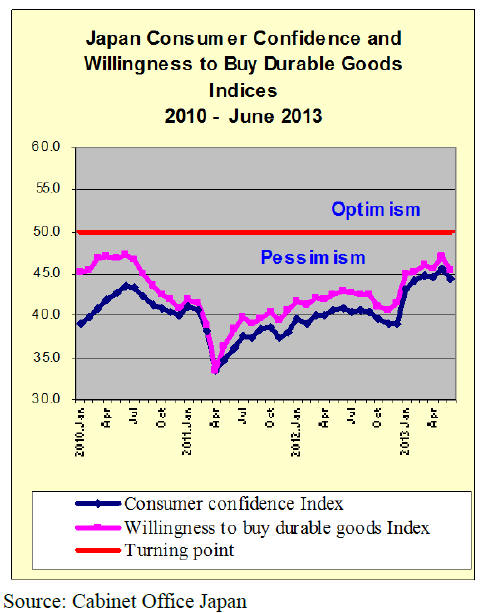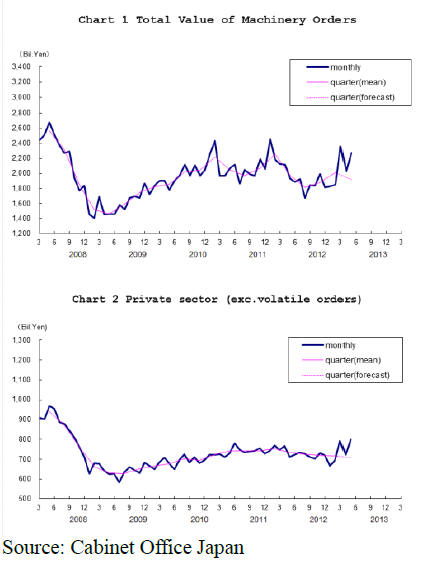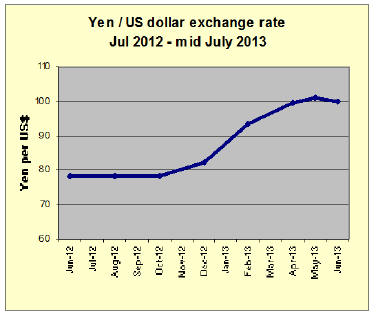Japan Wood Products
Prices
Dollar Exchange Rates of
12th July 2013
Japan Yen 101.15
Reports From Japan
Consumer confidence falls on concerns for income
growth and price rises
Japanese consumer confidence declined in June marking
the first fall in six months.
The main reason cited for the fall was consumer
expectations for rising prices and stagnant income growth.
For the Cabinet Office data see:
http://www.esri.cao.go.jp/en/stat/shouhi/shouhi-e.html

The latest survey shows that ‘household sentiment’ fell to
44.3 in June, down 1.4 points from the level in May. See:
http://www.esri.cao.go.jp/en/stat/juchu/1305juchue.
html#g01
Household sentiment covers consumer expectations for
overall ‘livelihood’ as well as income growth
expectations, employment and a willingness to buy
durable goods. All four of these elements declined June in
the survey. A consumer confidence number below 50
indicates pessimistic expectations.
Japanese companies finally begin expansion
investment
In Japan, private sector machinery orders are used as an
indicator of private sector investment trends. In the
statistics from the Cabinet Office the data exclude orders
placed by very large companies such as electric power
companies it also excludes orders for ships.

The Cabinet Office report for May says the total value of
machinery orders increased by 12% in May from the
previous month.
These latest figures, along with the results of the Bank of
Japan's Tankan survey, suggest companies in Japan are
planning to expand investment.
Stimulating private sector investment is at the heart of the
government's plan to reverse the weakening economy and
get the Japanese economy back onto a growth path.
Improved profits should lift household income and
business investment
In its Monthly Economic Report the Cabinet Office is now
painting a more optimistic picture for the Japanese
economy. See:
http://www5.cao.go.jp/keizai3/getsurei-e/2013jun.html
In summary the report says:
the Japanese economy is picking up steadily
exports show movements of picking up
industrial production is picking up
corporate profits are improving, mainly among
manufacturers
business investment is starting to level off
firms’ judgment on current business conditions
shows movements of improvement
the employment situation is improving, although
some severe aspects remain
private consumption is picking up
However the report cautions that “recent price
developments indicate that the Japanese economy is in a
mild deflationary phase, while signs of change have
recently been seen in some areas”.
In the short term a recovery may take hold if improved
corporate profits lead to higher incomes and business
investment. Much now depends on growth in exports but,
as the report points out, weakness in overseas economies
is a downside risk for the Japanese economy.
The good news is that private consumption and company
investment is picking up. If consumers see incomes
improving, says the report, a measure of sustainability in
growth may be achieved.
Positive growth in the housing sector is also adding to the
overall impression that a turn-around in the economy is
possible. Construction of owner occupied homes and
houses built for rent has picked up and sales of
condominiums in the Tokyo metropolitan area have been
increasing. The report notes that exports are increasing.
Exports to Asian countries remain subdued but exports to
the U.S. are showing improvement but exports are not
growing.
Bank of Japan stance creates more exchange rate
volatility
The US dollar was trading at yen 98 in early July. The
dollar was sold after comments from the Federal Reserve
suggested the US stimulus programme would have to be
continued for some time yet.

However the yen strengthened against the US dollar in the
past weeks largely because the Bank of Japan did not offer
any further indication that it would expand its monetary
easing initiative.
Trade news from the Japan Lumber Reports (JLR)
The Japan Lumber Reports (JLR), a subscription trade
journal published every two weeks in English, is
generously allowing the ITTO Tropical Timber Market
Report to extract and reproduce news on the Japanese
market.
The JLR requires that ITTO reproduces newsworthy text
exactly as it appears in their publication.
For the JLR report please see:
http://www.nmokuzai.
com/modules/general/index.php?id=7
Plywood market
The market of both imported and domestic produced
plywood continues firm trend with the prices edging up.
Shipment of domestic plywood has been brisk for
precutting plants and house builders. Both production and
shipment in May exceeded 210 M cbms.
The shipment has been over 200 M cbms for eight straight
months then the monthly production has also been over
190 M cbms for nine straight months.The inventory
increased by 5,000 cbms in May but remains at low level
of 127 M cbms.
Plywood manufacturers hold aggressive stance and keep
increasing sales prices little by little in every month.
Currently in Tokyo market, 12 mm 3x6 (special type/F4
star) prices are 950 yen per sheet delivered, 20 yen higher
than June, 24 mm 3x6 prices are 1,900 yen, 30 yen up,
long sheet 9 mm 3x10 prices are 1,370 yen , unchanged
from June.
Imported plywood market is firm with higher FOB prices
offered by the suppliers. Log supply shortage and higher
log cost continue in Malaysia so that there is no sign that
FOB prices would slack.
With this background, the market in Japan continues firm
despite higher port inventories and higher arrivals in April
and May over 340 M cbms.
Shipments in the second quarter were slower but the cost
of future arrivals is higher so importers and wholesalers
are holding firm stand.

Benefit for low income house buyers
The Tax Commission of controlling parties made up a
plan to give cash benefit for low income house buyers,
which are not able to take advantage fully of housing
mortgage loan tax reduction after the consumption tax
increase in April 2014.
For ones whose annual income is less than 5.1 million yen,
maximum of 300,000 yen cash is given when consumption
tax rate is 8% then when the rate is raised to 10%,
maximum of 500,000 yen is given, whose annual income
is less than 7.75 million yen.
Also in case house buyer with age of 50 or older pays cash
to buy a house with annual income of less than 6.5 million
yen, the same benefit is applied.
The government extended the housing loan tax reduction
measure, which was supposed to end in March 2014, for
four more years to March 2017. This is to relieve housing
market, which is likely to drop when the consumption tax
is raised.
This is the system to deduct 1% of housing loan balance
from the income with the maximum deduction of 200,000
yen but the amount is changed to 400,000 yen after the
consumption tax is raised in April 2014.
However, this system is beneficial to higher income
people, whose annual income is more than 6 million yen
so to make the measure fair for low income house buyers,
cash benefit is newly proposed.
Wood Use Point System
The administration office of the Wood Use Point System
publicized list of 545 products by 30 companies of wood
products (furniture, office furniture), 600 products by 61
manufacturers of wood stove, 1,348 products by 22
manufacturers of interior and exterior materials and 705
official windows for point issuance and for application of
trade of the points. Also it announced that additional
builders for the system are invited since July 8.
Wood products are bed, desk, table, chair, bookshelf,
partition, bench, counter, storage cabinet and cupboard
manufactured by Izumo Wood Works, Itoki, Uchida
Youkou, Okamura, Kokuyo Furniture, Xience, Toa
Ringyo, Dream Bed, Yoshiken、Teikoku Kizai, Hida
Sangyou, Wise Wise Inc. and others.
Manufacturers of registered building materials for interior
and exterior are Daiken, Eidai, Nichiha, Shimane
Plywood, Sato Kougyo, Marutama Sangyo, Pal Wood,
Noda, Kariya Annex, AP Floor (Akita Plywood), Chubu
Flooring, Sato Kogyo, Sorachi Veneer, Sumitomo Ringyo
Crest, Seihoku Plywood, Japan Kenzai, Kohoku Veneer,
Fujishima Wood Manufacturing and others.
In 22 companies, 21 are interior materials manufacturers
(5 interior wall, 19 floor and some are both). Windows for
application vary by prefectures but they are mainly
selected from group of architects, construction companies,
wood products distributors and forest unions.
JAS rules on CLT
The Ministry of Land, Infrastructure and Transport has
made up draft of JAS rules on CLT (cross laminated
timber) and is inviting public opinions through July 12.
JAS draft specifies formation of lamina, lamina quality,
adhesive, formaldehyde emission, species and test method.
After public opinions are collected in July, official rule of
JAS on CLT is expected to be issued by the year end.
Lamina has to be 12 mm or thicker and less than 50 mm in
thickness and basically even in thickness. Width is less
than 300 mm. Type of adhesive is specified depending on
environment and direction of gluing.
Once JAS rule is officially enacted, the Ministry of Land,
Infrastructure and Transport sets standard strength so that
CLT can be used as structural materials.
Revision of JAS rule on LVL
The National LVL Association formed JAS revision
committee since four years ago and the Association thinks
that LVL use is limited if it is used as structural post and
beam and it is necessary to develop market of LVL as
panel so it hopes that the revision this time would
contribute developing new market area for LVL.
In revised rule, there will be two type of structural LVL.
One is standard structural LVL of type A then type B
allows use of orthogonal layer into LVL freely to some
extent. For more information see Japan Lumber Reports
No 613 of July 12th.
|